You are using an out of date browser. It may not display this or other websites correctly.
You should upgrade or use an alternative browser.
You should upgrade or use an alternative browser.
Gráfica Intel Arc Discrete GPUs
- Autor do tópico Nemesis11
- Data Início
Ele colocou a dúvida sobre se o TDP era só para o "Core" ou era o total. A diferença seriam ~25w.
Exclusive: Is Intel’s Arctic Sound already dead? – Two existing models with specs, pictures and some questions
Arctic Sound – 1T and 2T
At this point I can already confirm that Arctic Sound relies on HBM 2E,
However, if you look at the variants listed now, it seems that Intel either ran out of courage, or the chips simply weren’t completely feasible that way.
But that only applies to the consumer chips, because this one is definitely bigger. If you stick to the name and the 1T as an indication for the number of tiles, then 1 tile (chiplet) in Intel’s Arctic Sound contains up to 512 EUs, which is quite huge. If one independently uses the known scheme for the distribution of EU and shader, this would mean 8 shader units per EU, so a total of 3072 shaders for the 1T card shown here, because one has activated only 384 EUs instead of 512 for this card.
The smaller of the two cards has a total of 16 GB HBM 2E and a bandwidth of up to 716 GB/s. What is interesting now, however, is the specified TDP for the card, which is 150 watts. This is interesting, because 75 watts per consumer tile with 128 EUs each were reported and one could have expected 225 watts if there had been three small tiles. The fact that there are now only 150 watts suggests that lower clock rates are (have to be) used here and a maximum expansion with 512 EU could not be implemented or the yield rate simply does not allow it. Or both, for that matter.
Intel specifies FP32 and FP64 (non-systolic) as well as BF16/FP16, Int8 and Int4 as supported numeric formats for both cards. PCIe 4.0 is also set as interface for communication with the CPU, other ATS cards or ATS nodes, but there are no video outputs.
Intel Arctic Sound 1T
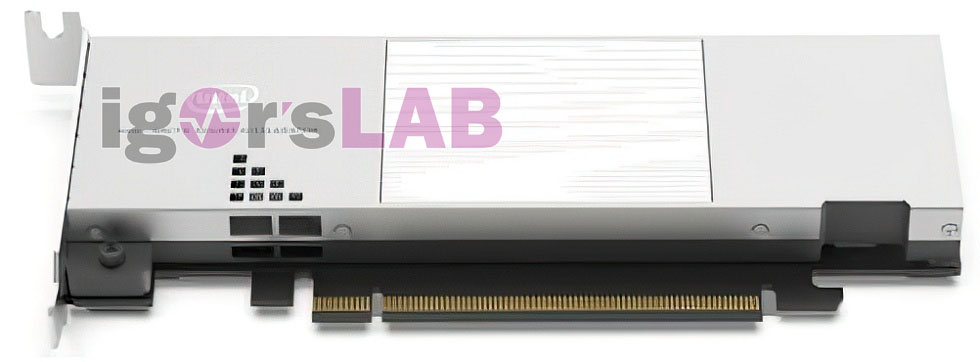
The configuration of the large card in the dual-slot design (DW), which Intel specifies with “480 x 2 execution units”, also shows that there is still a bit of a problem with the full configuration. You bet on 2T here, so 2 tiles if you follow the logic. But again, you don’t use the full number of 512 EUs available per unit. Instead of the theoretically possible 512 EUs in total, in practice there are only 480 per unit. But this still results in 2x 3840 shaders or 7680 EUs in the sum of both tiles. The memory expansion is stated as 32 GB HBM 2E, so probably 2x 16 GB to be quite accurate.
Intel specifies the TDP with only 300 watts, which suggests even lower clock rates and again problems with the implementation. What you can see here on a photo is the 8-pin EPS connector, which NVIDIA also uses for the 300 watts of the Quadro RTX A6000 and which should be enough. You can also see that the card in the picture was mounted in a special PCIe cage and is not directly on the motherboard.
Intel Arctic Sound 2T

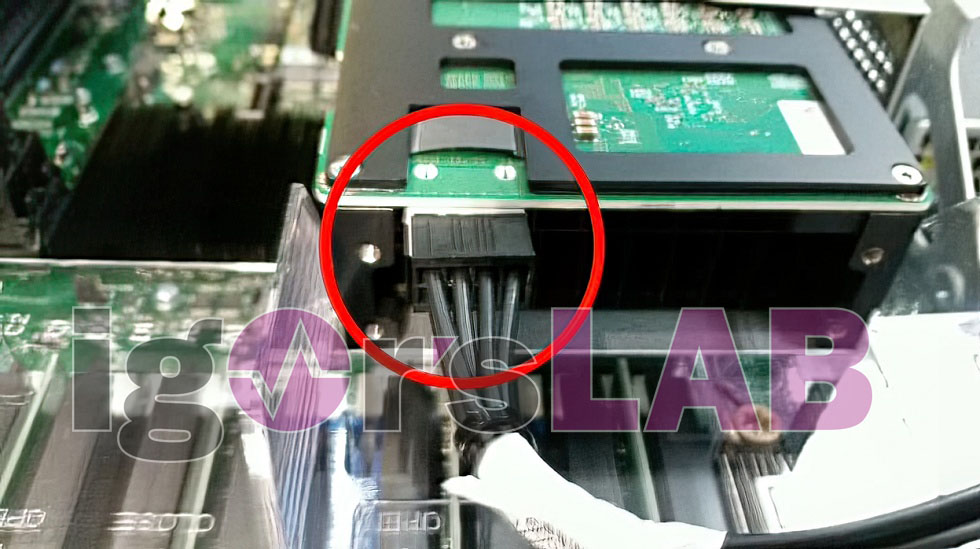
https://www.igorslab.de/en/exclusiv...two-existing-models-total-specs-and-pictures/And what conclusions can be drawn from this? Speculations are of course always such a thing, because one must also remain fair and not intentionally badmouth anything. But it really does seem by now that Intel has already internally given up on Arctic Sound, at least in its broad variability. Neither card exploits the full potential and comes across as a compromise that has become necessary, but not as a euphorically brandished spearhead that testifies to a new self-confidence. This is a rather modest concession and the obvious realization that they probably wanted more at the beginning than they could then manage in reality. Because the announced 3T or 4T cards are completely missing from the current list.
Nemesis11
Power Member
Eu não percebo bem este artigo. Mudou alguma coisa em relação ao plano original?
Chips "cortados" é normal. Gráficas com clocks mais baixos em Servidores é normal.
A versão com Tiles de 128 EUs será igual à de 512 EUs, para se poder calcular TDPs entre elas? Ainda por cima quando a versão consumidor usa memória que consome menos (HBM2E) que GDDR6? As EUs são iguais?
Estranhar estes valores de TDPs em servidores, quando eles têm que ser certificados para certos valores? Estranhar ela estar montada numa Cage, com o que parece ser um Riser?
Só por cima não vejo nada de errado nestas informações. A única coisa que pode ser mais preocupante é a versão de 4 Tiles ainda não aparecer nas listas, quando a Intel já a mostrou. Mas isso significa que está cancelada?
Chips "cortados" é normal. Gráficas com clocks mais baixos em Servidores é normal.
A versão com Tiles de 128 EUs será igual à de 512 EUs, para se poder calcular TDPs entre elas? Ainda por cima quando a versão consumidor usa memória que consome menos (HBM2E) que GDDR6? As EUs são iguais?
Estranhar estes valores de TDPs em servidores, quando eles têm que ser certificados para certos valores? Estranhar ela estar montada numa Cage, com o que parece ser um Riser?
Só por cima não vejo nada de errado nestas informações. A única coisa que pode ser mais preocupante é a versão de 4 Tiles ainda não aparecer nas listas, quando a Intel já a mostrou. Mas isso significa que está cancelada?
De certa forma confirma a "Radeon GCN approach", que basicamente o die tem de duplicar a sua função em Consumer e Pro.
Agora o busílis da questão deve ter a haver com a certificação, que as Pro terão de passar, e dado que isso demora sempre alguns meses e ainda nada de versão Consumidor.
(Quer NVIDIA quer AMD lançam sempre primeiro a versão Consumidor e alguns meses depois as Pro)
Agora daqui concluir que "desistiram" da versão Consumer...
Agora o busílis da questão deve ter a haver com a certificação, que as Pro terão de passar, e dado que isso demora sempre alguns meses e ainda nada de versão Consumidor.
(Quer NVIDIA quer AMD lançam sempre primeiro a versão Consumidor e alguns meses depois as Pro)
Agora daqui concluir que "desistiram" da versão Consumer...
Nemesis11
Power Member
A informação é interessante e ele pode ter razão, mas com aquela info, nem vejo como se pode especular na "desistência". Se tivesse informação com preços altos, performance baixa, yelds baixos ou se a Intel a substituísse com uma arquitectura nova dentro de 6 meses, ou se a versão de 4 tiles nunca aparecer, aí podia-se pensar nisso.
Além disso, a Intel nunca poderá ter grandes expectativas numa 1ª geração, no mercado empresarial. Poderá ser usada um pouco no mercado HPC, talvez enconding e em produção, não muito mais. Mesmo no mercado consumidor, será muito complicado numa 1ª geração.
Além disso, a Intel nunca poderá ter grandes expectativas numa 1ª geração, no mercado empresarial. Poderá ser usada um pouco no mercado HPC, talvez enconding e em produção, não muito mais. Mesmo no mercado consumidor, será muito complicado numa 1ª geração.
Correctomondo, daí ter falado em "GCN Approach", que foi a mesma abordagem do Raja aquando do regresso à AMD, um die genérico, e não me surpreenderia se o rácio FP64/FP32 fosse de 1/4 ou até 1/2 como foi nas primeiras gerações GCN, precisamente com a intenção de abarcar a maior fatia de mercado. Hoje em dia deve haver AI e ML cenas, quase obrigatório...
Há que dar crédito ao Igor, ele parece ter fontes no que diz respeito à Intel GPU, até porque não é o 1º artigo sobre os mesmos, mas tal não significa que tudo o diz seja correcto. Já houve outros que tiraram informações incorrectas com a informação que tinham, mas lá está, a informação que tinham tinha falhas.
Nada nos garante que haja duas equipas a trabalhar o mesmo die, na sua vertente Consumer e Pro, e a informação pode ter vindo apenas de uma das equipas.
Aguardar e ver o que sai daqui, sendo certo que a prioridade da Intel é quase de certeza o mercado mobile e OEM para PC assemblados, onde podem fazer um lock no mercado e ganhar mercado a partir daí.
Há que dar crédito ao Igor, ele parece ter fontes no que diz respeito à Intel GPU, até porque não é o 1º artigo sobre os mesmos, mas tal não significa que tudo o diz seja correcto. Já houve outros que tiraram informações incorrectas com a informação que tinham, mas lá está, a informação que tinham tinha falhas.
Nada nos garante que haja duas equipas a trabalhar o mesmo die, na sua vertente Consumer e Pro, e a informação pode ter vindo apenas de uma das equipas.
Aguardar e ver o que sai daqui, sendo certo que a prioridade da Intel é quase de certeza o mercado mobile e OEM para PC assemblados, onde podem fazer um lock no mercado e ganhar mercado a partir daí.
Novo artigo...

https://www.igorslab.de/en/intel-xe...different-chips-new-foils-and-certifications/
Deduzo que tenha sido isso que levou à conclusão do artigo anterior, apenas as SKU4 e SKU5 têm lançamento "oficial" previsto com os portáteis Alder Lake P, as outras deverão ser lançadas algures no Q1 2022, mas ainda sem previsão.
Intel Xe-HPG based DG2 with 5 different chips – new slides and confirmations
The slide also confirms the individual expansion stages with the different EU numbers of the respective SKUs, as well as the package used, of which one expects a total of 2 different sizes with different pin numbers (BGA 2660 and BGA 1379). Whether the largest version with 512 EUs will be available right away and in which order Intel will then launch the large SKUs on the dedicated graphics cards in 2022, on the other hand, is still completely unclear. The launch of the two smaller versions was already planned for the end of 2021 together with Alder Lake-P and the launch of SKU1 to SKU3 then gradually in Q1 2022.

https://www.igorslab.de/en/intel-xe...different-chips-new-foils-and-certifications/
Deduzo que tenha sido isso que levou à conclusão do artigo anterior, apenas as SKU4 e SKU5 têm lançamento "oficial" previsto com os portáteis Alder Lake P, as outras deverão ser lançadas algures no Q1 2022, mas ainda sem previsão.
DG2 512 by Raja....
B0 segundo percebo pelas marcações a caneta
B0 segundo percebo pelas marcações a caneta
GUNNIR shows off Iris Xe (Intel DG1) graphics card with a VGA port
Intel has a special website dedicated to Iris Xe SKU, where it currently shows two models: ASUS DG1 and GUNNIR Blue Halberd.

https://videocardz.com/newz/gunnir-shows-off-iris-xe-intel-dg1-graphics-card-with-a-vga-port
Artigo sobre o Ponte Vecchio, ou melhor o socket e sistema de cooling 
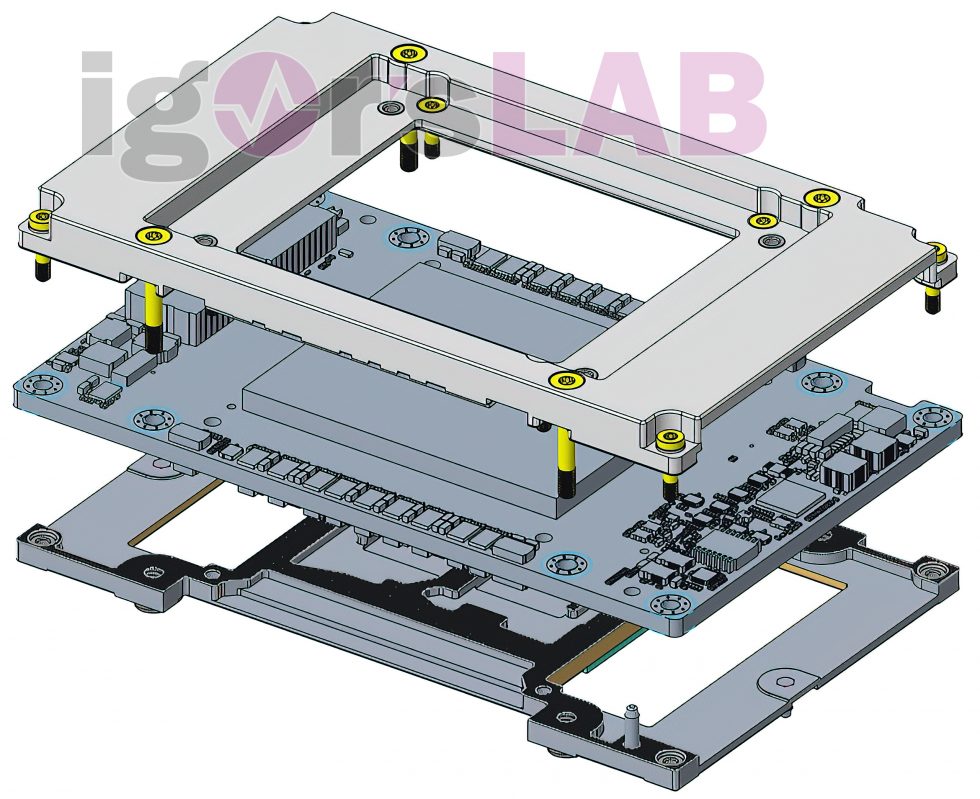
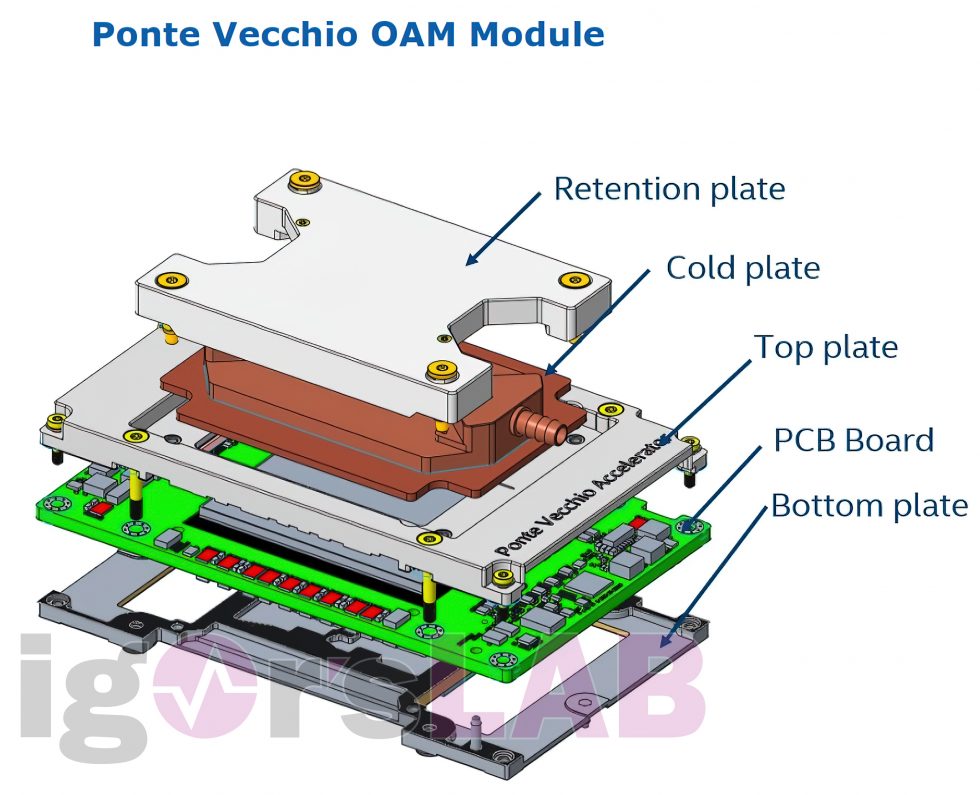
https://www.igorslab.de/en/everythi...super-power-consumption-needs-a-super-cooler/
Everything Super at Intel’s Ponte Vecchio – Supercomputer GPU with Super Power Consumption Needs a Super Cooler | Exclusive Leak


https://www.igorslab.de/en/everythi...super-power-consumption-needs-a-super-cooler/
DiogoAntunes
Power Member
Para o consumo ate acho cooler bem pequeno.
Nemesis11
Power Member
Aquilo usa Water Cooling e em servidores com Water Cooling, a parte de arrefecimento é externa à caixa do Servidor. Pode estar no próprio Rack ou, mais provável neste caso, algures no DC externo ao Rack.
Além disso, sendo um servidor, se tiver algum tipo de air cooling interno, nunca será directamente nos Chips. O cooling em servidores fica exclusivamente na Caixa.
Por tudo isto, não dá para avaliar a dimensão do Cooling, tendo apenas o Bloco, mas sabendo que ele terá um TDP de 600 ou mais W e um consumo total que andará perto dos 60 MW (Segundo a Wikipedia), a parte de Cooling deste SuperComputador vai ser em grande.........
O problema maior é que se calhar a AMD, usando Epycs e Radeon Instincts, irá conseguir criar um SuperComputador com mais 1/3 da Performance, a consumir quase metade e estar em produção ainda antes, com o Frontier.
Além disso, sendo um servidor, se tiver algum tipo de air cooling interno, nunca será directamente nos Chips. O cooling em servidores fica exclusivamente na Caixa.
Por tudo isto, não dá para avaliar a dimensão do Cooling, tendo apenas o Bloco, mas sabendo que ele terá um TDP de 600 ou mais W e um consumo total que andará perto dos 60 MW (Segundo a Wikipedia), a parte de Cooling deste SuperComputador vai ser em grande.........
O problema maior é que se calhar a AMD, usando Epycs e Radeon Instincts, irá conseguir criar um SuperComputador com mais 1/3 da Performance, a consumir quase metade e estar em produção ainda antes, com o Frontier.
Intel Iris Xe (DG1) discrete GPU from ASUS has been tested


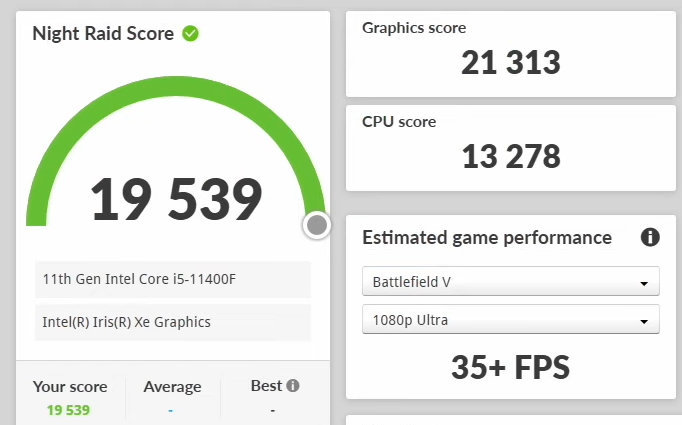



https://videocardz.com/newz/intel-iris-xe-dg1-discrete-gpu-from-asus-has-been-tested
Intel DG2 set to compete with NVIDIA GA104 and AMD Navi22 GPUs
https://videocardz.com/newz/intel-dg2-set-to-compete-with-nvidia-ga104-and-amd-navi22-gpus
Dependendo do preço pode ser um sucesso. A Nvidia e AMD andam demasiado ocupadas a fabricar produtos com margens elevadas, há imenso espaço no mercado para a Intel capturar market share no low end e budget build.
strafejump
Power Member
Competir com o ga104 e navi22 não é low end, muito menos budget 
A versão de 128EU's sim, mas acho que mais importante que o preço, os drivers vão ser factor fundamental para causar boa impressão inicial. Espero que a intel não cometa os mesmos erros que a amd.

A versão de 128EU's sim, mas acho que mais importante que o preço, os drivers vão ser factor fundamental para causar boa impressão inicial. Espero que a intel não cometa os mesmos erros que a amd.



